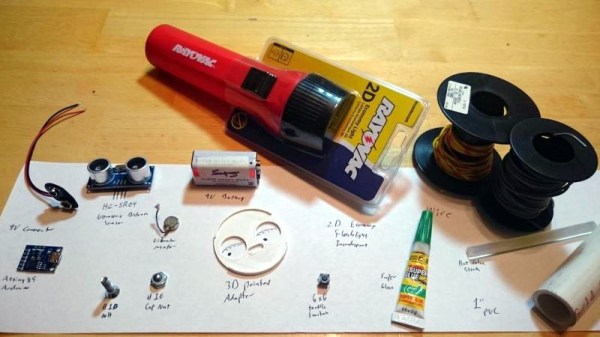vibration41 Articles
Hackaday Prize Entry: Shakelet
A person who is deaf can’t hear sound, but that doesn’t mean they can’t feel vibrations. For his Hackaday Prize entry, [Alex Hunt] is developing the Shakelet, a vibrating wristband for that notifies hearing impaired people about telephones, doorbells, and other sound alerts.
To tackle the difficulty of discriminating between the different sounds from different sources, [Alex’s] wants to attach little sound sensors directly to the sound emitting devices. The sensors wirelessly communicate with the wristband. If the wristband receives a trigger signal from one of the sensors, it alerts the wearer by vibrating. It also shows which device triggered the alert by flashing an RGB LED in a certain color. A first breadboard prototype of his idea confirmed the feasibility of the concept.
After solving a few minor problems with the sensitivity of the sensors, [Alex] now has a working prototype. The wristband features a pager motor and is controlled by an ATMEGA168. Two NRF24L01+ 2.4 GHz wireless transceiver modules take care of the communication. The sound sensors run on the smaller ATTiny85 and use a piezo disc as microphone. Check out the video below, where Alex demonstrates his build:
Listen Up: IPhone Hack Diagnoses HVAC
We all know that guy (or, in some cases, we are that guy) that can listen to a car running and say something like, “Yep. Needs a lifter adjustment.” A startup company named Augury aims to replace that skill with an iPhone app.
Aimed at commercial installations, a technician places a magnetic sensor to the body of the machine in question. The sensor connects to a custom box called an Auguscope that collects vibration and ultrasonic data and forwards it via the iPhone to a back end server for analysis. Moving the sensor can even allow the back end to determine the location of the fault in some cases. The comparison data the back end uses includes reference data on similar machines as well as historical data about the machine in question.
Vibrating Distance Torch Illuminates The Dark Without Light
If you’ve ever had to move around in a dark room before, you know how frustrating it can be. This is especially true if you are in an unfamiliar place. [Brian] has attempted to help solve this problem by building a vibrating distance sensor that is intuitive to use.
The main circuit is rather simple. An Arduino is hooked up to both an ultrasonic distance sensor and a vibrating motor. The distance sensor uses sound to determine the distance of an object by calculating how long it takes for an emitted sound to return to the sensor. The sensor uses sounds that are above the range of human hearing, so no one in the vicinity will hear it. The Arduino then vibrates a motor quickly if the object is very close, or slowly if it is far away. The whole circuit is powered by a 9V battery.
The real trick to this project is that the entire thing is housed inside of an old flashlight. [Brian] used OpenSCAD to design a custom plastic mount. This mount replaces the flashlight lens and allows the ultrasonic sensor to be secured to the front of the flashlight. The flashlight housing makes the device very intuitive to use. You simply point the flashlight in front of you and press the button. Instead of shining a bright light, the flashlight vibrates to let you know if the way ahead is clear. This way the user can more easily navigate around in the dark without the risk of being seen or waking up people in the area.
This reminds us of project Tacit, which used two of these ultrasonic sensors mounted on a fingerless glove.
Vibe Mirror

We love a good art-related project here at Hackaday, and [Wolfgang’s] vibrating mirror prototype is worth a look: into its distorting, reflective surface, of course.
[Wolfgang] began by laser cutting nine 1″ circles from an 8″ square mirror, then super glued a 1/4″ neoprene sheet to the back of the square, covering the holes. Each circular cutout received some custom acrylic backings, glued in place with a short piece of piano wire sticking out of the center. The resulting assemblage pushes through the neoprene backing like a giant thumbtack, thus holding all nine circular mirrors in place without restricting movement. The back end of the piano wire connects to yet another piece of acrylic, which is glued to a tiny vibrating motor.
He uses some shift registers and an Arduino Uno to control the motors, and although there’s no source code to glance it, we’re guessing [Wolfgang] simply designed the nine mirrors to buzz about in different patterns and create visually interesting compositions. Check out a quick video of the final effect after the break, and if you can help [Wolfgang] out with a name for his device, hit us up with your suggestions in the comments.
The Most Surprising Game Of Simon You’ve Every Played

How does one take a game of Simon and make it extremely awesome? The folks at the North Street Labs — a Hackerspace in Portsmouth, Virginia — have found the secret and it’s all in the execution. They turned this chair-desk into a coin-operated Simon game that hides a huge surprise.
We suppose you should be able to guess the secret. Most coin-operated sidewalk attractions are rides, and so is this. As their Red Bull Creation entry the team built a base for the desk around a 2000 Watt floor buffer. These are the kind of things that you’d see a janitor in the 1980’s using to polish the tiles of your middle-school. This one just happens to shake the bejesus out of a player who makes a mistake. To help suck you into the game this won’t happen right away. You have to make it past at least four rounds before making the mistake.
The rest of the game is as expected. The playing area is nicely milled from a piece of wood with acrylic windows serving as the buttons. Apparently the biggest problem with that part of the build is finding a way to hold everything together despite the intense vibrations. See for yourself in the clip after the break.
Continue reading “The Most Surprising Game Of Simon You’ve Every Played”
Echo Box Shakes Itself To Make Sound

The echo box performs exactly as its name implies. If you tap out a rhythm on the lid, it will tap the same thing back to you. Except it isn’t tapping to make the sound, but vibrating.
The concept is similar to the Knock Block. In that hack, a piezo element detected a rapping on the wooden enclosure and repeated the rhythm by striking the lid with a solenoid. This iteration also uses a piezo element as the sensor. In the image above you can see a segment of PVC pipe in the upper corner. That houses the element, sandwiched between two pieces of wine bottle cork. That cork just touches the lid of the box, transferring the vibrations to the element.
The sound is created by a motor with an offset weight on its spindle. When the motor spins, it causes vibrations. The enclosure is one wood box inside of another, so the vibrating motor cause the inner box to shake against the outer one to make noise. Hear it for yourself in the clip after the break.














